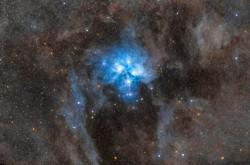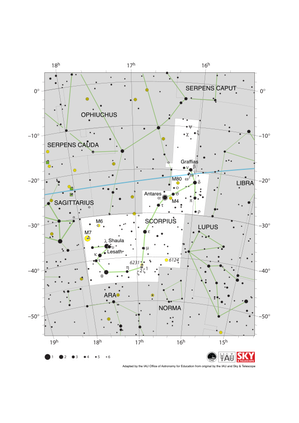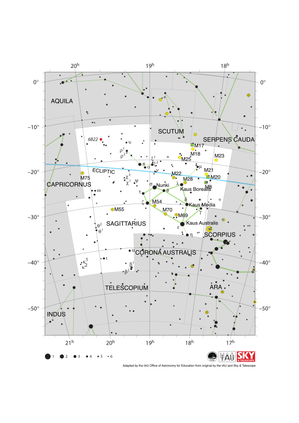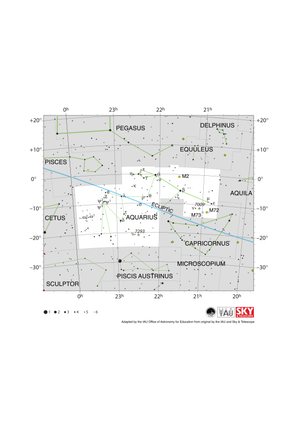Glossarbegriffe: Offener Sternhaufen
Description: Offene Sternhaufen sind Sternhaufen, die in unserer Milchstraße und anderen Galaxien zu finden sind. Sie können aus vielen Hunderten oder sogar Tausenden von Sternen bestehen. Man nimmt an, dass ein offener Sternhaufen entsteht, wenn sich eine große Gaswolke im All zusammenballt und so neue Sterne entstehen. Ein offener Sternhaufen wäre demnach das Ergebnis eines einzelnen solchen Sternentstehungsereignisses. In der Milchstraße befinden sich offene Sternhaufen meistens in der galaktischen Scheibe. Sie sollten nicht mit Kugelsternhaufen verwechselt werden: Die Sternen in ihnen sind nicht so stark durch die Gravitationskraft aneinander gebunden wie in Kugelsternhaufen. Das bedeutet, dass sich offene Sternhaufen im Laufe von Hunderten von Millionen Jahren allmählich auflösen und ihre Sterne Teil der allgemeinen Sternbevölkerung der Milchstraße werden. Als Gruppen von Sternen, die alle ein gemeinsames Alter haben, sind offene Sternhaufen ideal, um die Entwicklung von Sternen zu untersuchen. Die Plejaden sind vielleicht der berühmteste offene Sternhaufen am Himmel.
Zugehörige Glossarbegriffe:
- Galaktische Scheibe
- Kugelsternhaufen
- Milchstraße
- Sternhaufen
- Sternentwicklung
- Sternpopulation
- Plejaden
See this term in other languages
Term and definition status: The original definition of this term in English have been approved by a research astronomer and a teacher The translation of this term and its definition is still awaiting approval
The OAE Multilingual Glossary is a project of the IAU Office of Astronomy for Education (OAE) in collaboration with the IAU Office of Astronomy Outreach (OAO). The terms and definitions were chosen, written and reviewed by a collective effort from the OAE, the OAE Centers and Nodes, the OAE National Astronomy Education Coordinators (NAECs) and other volunteers. You can find a full list of credits here. All glossary terms and their definitions are released under a Creative Commons CC BY-4.0 license and should be credited to "IAU OAE".
If you notice a factual or translation error in this glossary term or definition then please get in touch.
Zugehörige Medien
Die Plejaden M45 mit majestätischem Staub
Bildnachweis: Mohamed Usama/IAU OAU
License: CC-BY-4.0 Creative Commons Namensnennung 4.0 International (CC BY 4.0) icons
Related Diagrams
Andromeda Constellation Map
Bildnachweis: Adapted by the IAU Office of Astronomy for Education from the original by IAU/Sky & Telescope
License: CC-BY-4.0 Creative Commons Namensnennung 4.0 International (CC BY 4.0) icons
Scorpius Constellation Map
Bildnachweis: Adapted by the IAU Office of Astronomy for Education from the original by IAU/Sky & Telescope
License: CC-BY-4.0 Creative Commons Namensnennung 4.0 International (CC BY 4.0) icons
Sagittarius Constellation Map
Bildnachweis: Adapted by the IAU Office of Astronomy for Education from the original by IAU/Sky & Telescope
License: CC-BY-4.0 Creative Commons Namensnennung 4.0 International (CC BY 4.0) icons
Aquarius Constellation Map
Bildnachweis: Adapted by the IAU Office of Astronomy for Education from the original by IAU/Sky & Telescope
License: CC-BY-4.0 Creative Commons Namensnennung 4.0 International (CC BY 4.0) icons
Crux Constellation Map
Bildnachweis: Adapted by the IAU Office of Astronomy for Education from the original by IAU/Sky & Telescope.
License: CC-BY-4.0 Creative Commons Namensnennung 4.0 International (CC BY 4.0) icons














